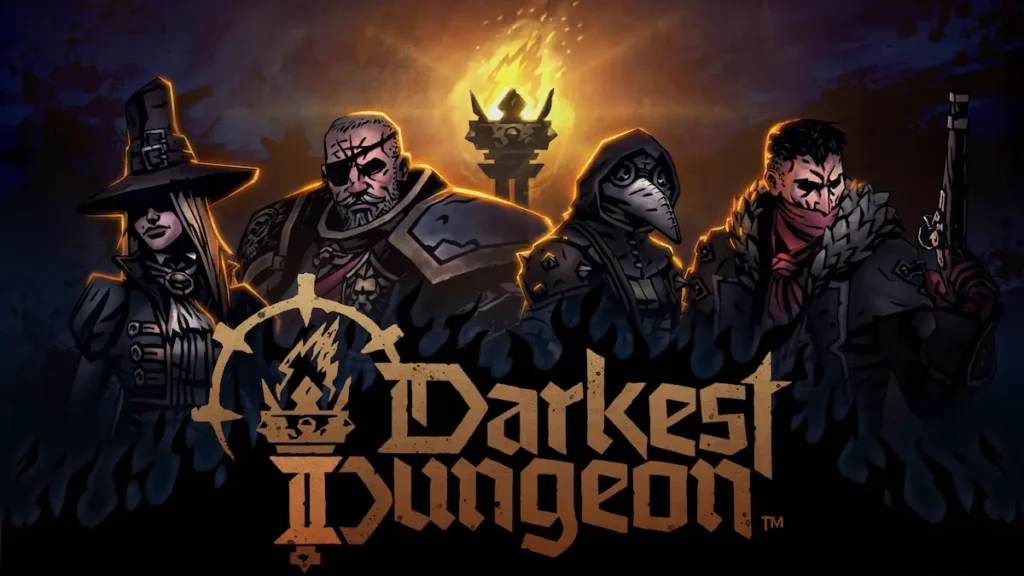Darkest Dungeon 2 flourish on its atmospheric and threatening vibe. The art and ambience are consistently bleak and melancholic, complemented by Wayne June’s different narration, which straighten out a compelling story of a quest gone wrong.
The background of this broken world is shown in small, tragic snippets after each run, offering new details to anticipate whether you win or lose.
The narrative establishes a clear sense that reality is deeply flawed and that it’s somehow your mistake, though the exact nature of your crimes takes time to unfold.
Each run in Darkest Dungeon 2 involves guiding four (probably doomed) heroes on a carriage ride through various deadly locales, from spooky forests to a fishing village inspired by Innsmouth.
You can guide the carriage to collect loot and map a strategic path at each fork in the road. This added layer of strategy and resource management was a highlight.
You can choose to get in more turn-based battles for additional loot or avoid them if your party is struggling. Some paths can damage your carriage, forcing you into desperate ambush battles if you break down.
The strategic choices are further complicated by the potential rewards and dangers of each route, such as encountering a hospital to remove negative feature but having to pass through an Oblivion Tear, which makes the entire region more perilous.
The carriage’s lantern dims as you travel, affecting your battle advantages. Encounters along the road gives tough choices, like reigniting the flame by helping refugees or taking their supplies. Each party member has opinions on your decisions, affecting their relationships.
The relationship system is central to Darkest Dungeon 2, where characters’ attitudes towards each other can lead to positive or negative effects. These relationships influence your success, making party unity crucial.
Relationships are semi-randomized, but you can change them by maintaining the flame and managing stress levels. The progression system is a satisfying mix of permanent power boosts and temporary gear and combat items.
This progression happens at the Altar of Hope, where you spend candles, the persistent currency, to improve classes and the carriage. Candles are earned through each leg of the journey and defeating act bosses, who require careful strategy to overcome.
Each class, from the straightforward Man-at-Arms to the unique Runaway and Flagellant, is enjoyable to play. But the starting abilities can feel underwhelming until you unlock more through Shrines of Reflection, which also shows the character’s backstory.
This mixture of mechanics and storytelling, coupled with rising tales from character relationships, adds emotional context to the game’s terror and bloodshed.
But one significant change that is not appreciated is the shift from recruiting multiple heroes of the same class to having only one of each. When a hero dies, they return with a new set of peculiarity but the same name, losing any invested buffs.
This makes it harder to form long-term attachments to characters, unlike in the first game. Relationships also reset between areas, which diminishes the impact of their development. This new system feels like an oversimplification that detracts from the emotional investment in the characters.
Conflict in Darkest Dungeon 2 is difficult but rewarding, with each action feeling like a puzzle. The variety in enemy groups and the strategic depth make each encounter engaging.
But the game’s interface is based on icons to communicate effects, with a glossary that is not always helpful. Some effects and abilities are not well-explained, which can be irritating.
Conclusion
Despite these problems, Darkest Dungeon 2 gives an enjoyable experience. The pacing is excellent, decisions feel meaningful, and the game’s art, music, story, and narration create a mesmerizing and sorrowful atmosphere.
The unique RPG classes and refined stress system add depth to the gameplay, making sure that I will keep my carriage’s flame burning for a long time.
Also read: Capcom Announces Resident Evil 9: Teases Fans with Minimal Details

